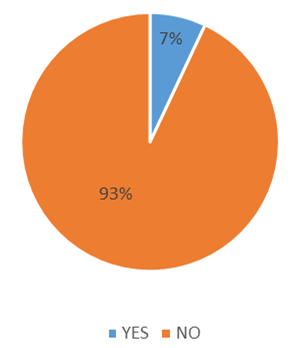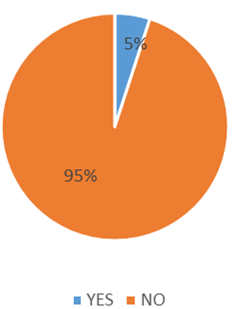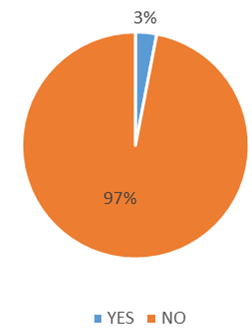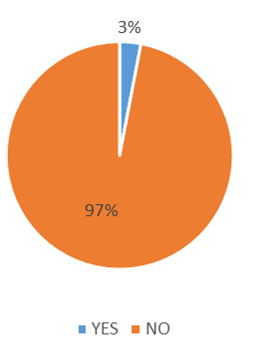Awareness About Medicinal Uses of Costus Pictus Plant Among Dental Students
Abstract
Costus igneus, typically known as searing costus, is native to South America ordinarily known as the insulin plant. It is typically grown in gardens mostly as a decorative herb in South India and is further out of control in other areas. It is used in India to combat hyperglycaemia and many other diseases. This survey was performed with the purpose of assessing the knowledge and the awareness about the Costus pictus medicinal plant amongst dental students. A cross-sectional survey was performed with a self-administered questionnaire with ten questions circulated among 100 dental students. The questionnaire assessed the awareness about Costus pictus plant, their medicinal uses, antidiabetic activity, antioxidant and antimicrobial activity. The responses were recorded and analysed.93% of the respondents were not aware of medical uses of Costus pictus .95% were not aware of antidiabetic activity of Costus pictus .97 % were not aware of the antioxidant activity of Costus pictus. Again 97% were not aware of the antimicrobial activity of Costus pictus. The knowledge and awareness about the medicinal Costus plant were less among dental students and awareness was created about its medicinal uses.
Keywords
Awareness, Costus, dental students, diseases
Introduction
Costus igneus ordinarily known as searing costus is local to South America ordinarily known as 'insulin plant. It is generally developed in gardens as a decorative plant in South India and go out of control in numerous places. It is utilized in India to control hyperglycaemia and numerous other illnesses (Jirovetz, Buchbauer, Shahabi, Shafi, & Rajeeve, 2003). It is broadly developed in gardens as a decorative plant in South India and go out of control in numerous places. This plant is used in India to control high blood sugar, and it is realized that diabetic individuals consume one leaf day by day to lower their blood glucose (Joseph et al., 2017). The plant has a place with the family Costaceae.
Consecutive exploration for phytocompounds of C. igneus leaves uncovered it is wealthy in proteins, iron, and cancer hindrance agents such as β carotene, ascorbic acid, terpinoids, steroids, α tocopherol, and flavonoids (Eliza, Daisy, & Ignacimuthu, 2010; Hegde, A, Kumar, & Rao, 2016). Explorative phytochemical assessment of Insulin plant uncovered that the leaves contain many medicinal properties. Examination of progressive concentrates demonstrated nearness of steroids in concentrates. The ethanolic extract contained alkaloids moreover. The significant segment of the ether division was α tocopherol, bis (2' Ethylhexyl) 1,2 benzene dicarboxylate (59.04%), and ergastanol (Thiruchenduran, 2018).
Stem indicated the nearness of terpenoid conjugate lupeol and steroid conjugate stigmasterol. Bioactive mixes quercetin, diosgenin, steroidal sapogenins, were fragmented from the C. igneus rhizome. Trace basic investigation indicated that the leaves and the rhizomes of C. pictus contain calculable measures of the components Chromium, Calcium, Manganese, Copper, Potassium, and Zinc (Talasila, Bavirisetti, Chimakurthy, & Candasamy, 2014). Steam refining of stem, leaves, and the rhizomes of the C. pictus D. The restorative employments of this plant can treat numerous oral wellbeing related conditions. This survey was performed with the purpose of assessing the knowledge and the awareness about the Costus pictus medicinal plant amongst dental students.
Materials and Methods
A cross-sectional survey was performed with a self-administered questionnaire with ten questions circulated among 100 dental students. The questionnaire assessed the awareness about Costus pictus plant, their medicinal uses, antidiabetic activity, antioxidant and antimicrobial activity. The responses were recorded and analysed.




Results and Discussion
93% of the respondents were not aware of medical uses of Costus pictus (Figure 1) .95% were not aware of antidiabetic activity of Costus pictus (Figure 2) .97 % were not aware of the antioxidant activity of Costus pictus (Figure 3). Again 97% were not aware of the antimicrobial activity of Costus pictus (Figure 4).
Shetty AJ et al. in a clinical investigation detailed patients are expending it is possible that one new leaf per day of C. igneus had adequately delivered glycemic control within diabetics (Shetty et al., 2010). A study assessed the capacity of tea produced using the leaves of C. spicatus to modify glucose-related homeostasis in C57BLKS/J (KS) db/db mice, a model of weight actuated hyperglycemia, with dynamic beta-cell consumption. Intraperitoneal insulin resistance test after study periods indicated that C. spicatus tea utilization didn't modify insulin affectability, which proposed that at the portion given, tea produced using C. spicatus had no adequacy in the treating obesity instigated hyperglycemia (Rao, Rao, & Hegde, 2014).
An examination was done to similarly assess the methanol and watery concentrates of C. igneus leaves in diabetes initiated hyperlipidemia in rodents. The examination uncovered methanol and fluid concentrates at a portion of 200 mg/kg body weight switched diabetes initiated hyperlipidemia.] Alcoholic concentrate of the C. igneus at the portion of 400 mg/kg (p.o) had altogether diminished the degrees of triglycerides, cholesterol, Low-Density Lipoprotein levels in Triton prompted hyperlipidemic rats (Selim & Jaouni, 2016; Shanmugavadivu & Velmurugan, 2018).
An investigation was done to gauge the diuretic impact of a watery concentrate of C. pictus D. The outcomes uncovered that C. pictus prompted a natriuretic impact like furosemide. The fluid concentrate incited an addition in potassium and sodium freedom like the one acquired with furosemide, recommending that it speaks to huge diuresis (Subramoniam, 2016).
An investigation of alcohol concentrate of leaves of C. mexicanus indicated moderate cancer prevention. In another investigation, methanolic leaf concentrate of C. pictus D. Wear caused a critical increment in catalase, glutathione peroxidase, superoxide dismutase, nutrient A, glutathione reductase, nutrient E, nutrient C,and decreased glutathione, and in this way, could be viable in lessening oxidative pressure and free radical intervened maladies. Methanolic concentrates of bloom and stem of C. pictus have in vitro cancer prevention agent action against the oxidative protein harm. Among the concentrates tried for, chloroform concentrate of C. pictus D. Wear bark had high cell reinforcement action. Oral organization of ethanolic concentrate of C. igneus rhizome at 200 mg/kg body weight to diabetic rodents for 30 days actuated a huge cancer prevention agent impact. The bioactive compounds diosgenin and quercetin present in the plant showed cell reinforcement action, which was adequate to turn around oxidative repair in liver, pancreatic and nephrotic tissue of diabetic rodents just as to invigorate glycolytic chemicals and control gluconeogenesis in diabetogenic animals (Tiko et al., 2019).
Hostile to microbial movement Methanolic concentrate of C. igneus demonstrated most extreme enemy of the bacterial movement against gram-positive Bacillus megaterium, Bacillus cerus, Staphylococcus aureus, Streptococcus lactis, Micrococcus leuteus, and gram-negative strains Escherichia coli, Pseudomonas aeruginosa, Klebsiella pneumoniae, Enterobacter aerogenes, and Salmonella typhimurium. The segregated compound from the ethanolic concentrate of Costus igneus indicated moderate enemy of bacterial and hostile to parasitic action against Eschericia coli, Staphylococcus aureus, and Candida albicans. Among the concentrates of different pieces of C. pictus, methanol concentrates of flowers showed most extreme inhibitory action on the development of tried microorganisms, viz., Klebsiella pneumonia, Shigella flexneri, Escherichia coli, Bacillus subtilis, at the grouping of 150 µg/ml (Nancy, Raj, & Manimekalai, 2019; Suganya, Narmadha, Gopalakrishnan, & Devaki, 2012).
The ethanolic concentrate of leaves of C. pictus was established to have hostility to malignant growth potential in fibrosarcoma cells. All the concentrates of bark had powerful anti-disease properties against HT 29 and also A549 cells (Sathuvan et al., 2012). This study assisted with making awareness about the restorative capability of Costus plant among dental students. Be that as it may, the remedial aftereffects of Costus must be additionally assessed and revalidated through clinical preliminaries. The hypoglycaemic impact of its leaves is at present been tried in hyperglycaemic patients. Studies uncover its function in different ailments, which open newer research domains.
Conclusion
The knowledge and awareness about the medicinal Costus plant were less among dental students and awareness was created about its medicinal uses besides, it clears new roads to investigate the mixes answerable for these remedial impacts in numerous oral sicknesses too.
Funding Support
The authors declare that they have no funding support for this study.
Conflict of Interest
The authors declare that they have no conflict of interest for this study.